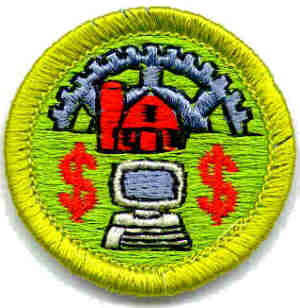
Agribusiness
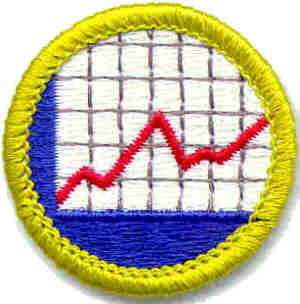
American Business
- Do the following:
- Explain four features of the free enterprise system in America. Tell its benefits and responsibilities. Describe the difference between freedom and license. Tell how the Scout Oath and Law apply to business and free enterprise.
- Describe the industrial revolution: Tell about the major developments that marked the start of the modern industrial era in the United States. Tell about five people who had a great influence on business or industry in the United States. Tell what each did.
- Do the following:
- Visit a bank. Talk with one of the officers or staff. Chart the organization of the bank. Show its relationship with other banks, business and industry.
- Explain how changes interest rates, taxes, and government spending change the flow of money into or out of business and industry.
- Explain how a proprietorship or partnership gets its capital. Discuss and explain four ways a corporation gets its capital.
- Explain the place of profit in business.
- Name five kinds of insurance useful to business. Describe their purpose.
- Do the following:
- Pick two or more stocks from the financial pages of a newspaper. Pretend to have bought $1,000 worth of these stocks. Explain how you "bought" the stocks. Tell why you decided to "buy" them. Keep a weekly record for 3 months of your stocks' market value. Show any dividends declared.
- Write to one company whose stock you "bought." Ask for a copy of its annual report. Explain it.
- Do the following:
- Draw an organizational chart of a typical central labor council.
- Describe automation, union shop, open shop, collective-bargaining agreements, shop steward, business agent, union counselor.
- Explain the part played by four different federal or state agencies in labor relations.
- Run a small business involving a product or
service for at least 3 months. First find out the
need for it. For example: a newspaper route, lawn
mowing, sales of things you have made or grown.
Keep records showing the costs, income and
profit. Report:
- How service, friendliness, hard work, and salesmanship helped build your business.
- The benefits you and others received because you were in business.
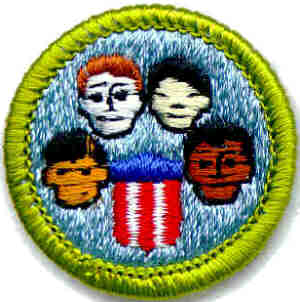
American Cultures
Choose TWO groups that have different racial, cultural, national, or ethnic backgrounds. Use these groups to meet requirements 1, 2, and 3. Also complete requirement 4 and either requirement 5a or 5b.
- Do TWO of the following, choosing a different
group for each:
- Go to a festival, celebration, or other
event identified with one of the groups.
Report on what you see and learn.
- Go to a church, clubhouse, school, or
other institution identified with one of
the groups. Report on what you see and
learn.
- Talk with a person from one of the groups
about the heritage and traditions of the
group. Report on what you learn.
- Learn a song, dance, poem, or story that
is traditional to one group, and teach it
to a group of your friends.
- Go to a library or museum to see a
program or exhibit featuring one group's
traditions. Report on what you see and
learn.
- Go to a festival, celebration, or other
event identified with one of the groups.
Report on what you see and learn.
- Imagine that one of the groups had always lived
in a city or country to which no other groups
ever came. Tell what you think the city or
country might be like today. Now tell what you
think it might be like if both groups lived there
at the same time.
- Tell about some differences between the religious
and social customs of the two groups. Tell about
some ideas or ways of doing things that are
similar in both groups.
- Tell about a contribution made to our country by
three different people, each from a different
background such as black American, white
American, Native American, Hispanic-American,
Asian-American, or any other background of your
choosing. Their backgrounds my be religious, as
well, such as Jewish, Muslims, Hindus, etc.
- Do ONE of the following:
- Give a talk to your troop or school class on how people from different groups have gotten along together. Lead a discussion on what can be done to help various groups understand one another better.
- Tell about some achievements of the
United Nations accomplished by people of
many cultures and beliefs working in one
organization. Tell how the U.N. has dealt
with some problems caused by conflicts
between different groups.
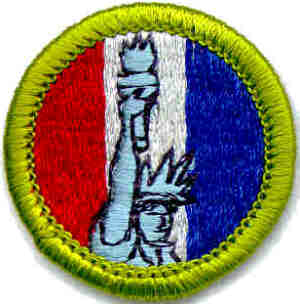
American Heritage
- Do ONE of the following:
- Make a map of your area. Mark the points of historical interest. Show your map in your classroom or troop meeting place. Tell about the points of historical interest.
- Research an event of historical importance that took place in or near your area. If possible, visit the place where the event took place. Tell your class or troop about the event and its impact on local history. Describe what it looked like then and now.
- Find out when, why, and how your town or neighborhood started. What ethnic, national, or racial groups played a part? Find out how it has changed over the past 50 years. Try to explain why.
- Do ONE of the following:
- Explain what is meant by the National Register of Historic places. Tell about any National register properties in your area. Describe how a property becomes eligible for listing.
- Find something in your area that seems to qualify for National Register listing. Bring it to the attention of the Historic Preservation Officer for your state. Assist him or her, in any way possible, to nominate it for inclusion in the National Register.
- Choose ONE of the following; describe its
adoption; tell about any changes since its
adoption.
- The flag
- The Pledge of Allegiance
- The seal
- The motto
- The national anthem
- Choose an event, a period, or person from United
States history that you would like to know more
about. Do FOUR of the following for the subject
chosen.
- Read a biography, approved by your counselor, of the person chosen. Tell some things you admire about the person. Tell about some of the thing you do not admire. Explain why you think this person had made a good or bad contribution to America's heritage.
- Read about the subject in three sources. List the major points upon which all agree. List areas of disagreement. Decide which source is mostly true. Tell how you decided.
- Read a historical novel or see a television show, a play, or a movie about your subject. Tell how true you think it was. Tell how it added to your understanding of the subject.
- Select an important speech related to your subject and tell when and why it was made. Read the speech to your class or troop. Then lead a discussion about the effect it had at the time.
- Gather records of four songs that are related to your subject or be able to sing or play them yourself. Play the records, or play or sing the songs yourself, for your class or troop. Tell about each song.
- Collect copies of four cartoons about your subject or draw two in the style of the period. Tell about the meaning of the cartoons.
- Collect copies of paintings about your subject. Show them to your class or troop. Tell about them Discuss their accuracy or symbolism.
- Collect copies of photographs about your subject. Show them to your class or troop. Tell how they reflect the photographer's point of view.
- Build a model to show something about your subject. Show the model to your class to troop. Tell about what it shows.
- Visit a historic site related to your subject. Tell your class or troop about the visit. Tell how it has enlarged your view of the subject.
- Make a time-line for your subject. Tell how the main events on your chart have affected life in America today.
- Do ONE of the following:
- Take an active part in a program about a historic event or person. Report to your Class or troop about the program, the part you took, and the subject.
- Pick and organization that is directly concerned with the preservation or perpetuation of local, state, or national history. Talk with an officer of the organization about its goals. Find out how you can help meet these goals. Carry out a project that will help meet the goals.
- Set up a historic trail or walk in your area. Prepare a guidebook. Include maps and related local history. Develop and carry out a plan to bring your trail to the attention of your community.
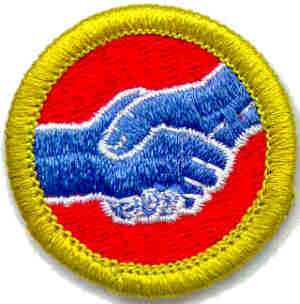
American Labor
- Do ONE of the following:
- Develop a time line of significant history of the American labor movement from the 1770's to today.
- Prepare an exhibit or a scrapbook illustrating three major achievements of the American labor movement
- In 500 words or more, write about one of the founders of organized labor in the United States.
- In 500 words of more, write how the work force fits into the economic system of the United States.
- Check with some news sources where you live -- public library, federal, states, county, or municipal employment office - for information about working people and their concerns. Discuss your findings with your counselor.
- Discuss with your counselor how you would lead a discussion on the subject of worker concerns about job- related issues. Issues should be related to the workplace (safety, job assignments, seniority, wages, child care, etc...)
- With the help of your counselor, prepare an
exhibit or scrapbook illustrating ONE of the
following:
- Issues that concern American workers.
- Federal and state labor laws showing how these laws affect American Workers.
- Current issues you have learned about from a national union or employee group.
- Visit the office or attend a meeting of a local union, an AFL-CIO labor council, or an independent employee organization. Talk with some people there and find out what the organization does. Draw a diagram of the organizational structure of the association you visited from the local to the national level, if applicable.
- Be prepared to define and discuss some of the key terms used in labor relations.
- With help from your counselor, determine some of the basic rights and responsibilities that members of unions, employee organizations, and those not belonging to a collective association have.
- With help from your counselor, chart a comparison of wages, benefits, and working conditions in a union shop and a nonunion shop in the same industry.
- Discuss why it is important to maintain good relationships among business, labor, and government. Describe to your counselor what can happen when these relationships get out of balance.
- Discuss with your counselor the different goals that may exist with owners of a business, its stockholders, its customers, its employees, the employees' representatives, the community, and public officials. Explain why agreements and compromises are made and how they affect each group in attaining its goals.
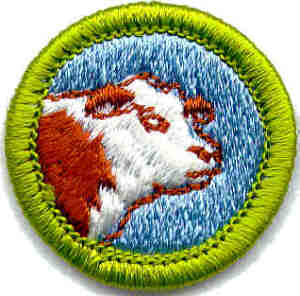
Animal Science
- Name four breeds of livestock in each of the following classifications: horses, dairy cattle, beef cattle, sheep, hogs. Tell their principal uses and merits. Tell where the breeds originated.
- List the principal diseases in your area that afflict the animals in each classification. Describe the symptoms and explain the proper treatment for the diseases you list.
- Explain the major differences in digestive systems or ruminant and nonruminant animals.
- Tell how you would properly manage a cow, sheep, horse, or hog, including adequate feeding. Tell what must be done to prevent illness, blemishes, defects, and disease arising from improper and unsanitary conditions.
- Tell about three career opportunities in livestock production.
- Complete ONE of the following options:
DAIRYING OPTION- Tell how a cow or goat converts forage and grain into milk.
- Make a chart showing the ingredients in cows' milk or goat's milk. Chart the amount of each.
- Tell the difference between certified and pasteurized milk. Tell how milk is pasteurized.
- Tell about the kinds of equipment and health standards for dairy farms.
- Visit a dairy farm or milk processing plant. Tell about your visit.
BEEF CATTLE OPTION
- Visit a farm or ranch where beef cattle
are produced under any of these systems:
- feeding market cattle for slaughter;
- producing feeder cattle for sale to commercial cattle feeders;
- producing purebred cattle for sale as breeding stock to other breeders.
Talk with the operator. Tell how the cattle were handled, fed, weighed, and shipped.
- Sketch a plan of a feedlot, hay and grain storage facilities, and loading chute for 30 or more fattening steers, or a corral plan with cutting and loading chutes for handling 50 or more beef cows and their calves at one time.
- Submit a sketch showing the principal wholesale and retail cuts of beef. Tell about USDA dual grading system of beef. Tell about the grades in each system.
HOG OPTION
- Visit a farm where hog production is a major project, or visit a packing plant or stockyard handling hogs. Describe your visit.
- Outline in writing the proper feeding from the breeding or gilt or sow through the weaning of the litter. Discuss the growth and finishing periods.
- Make a sketch showing the principal wholesale and retail cuts of pork. Tell about the recommended USDA grades of pork. Tell the basis for each grade.
HORSE OPTION
- Make a sketch of a useful saddle horse barn and exercise yard.
- Tell the history of the horse and the benefits it has brought to man.
- Tell about the following terms: mustangs, quarterhorse, pinto, draft, gelding, calico, palomino, pacer, trotter, filly, mare, stallion, colt, and foal.
- Visit a horse farm. Describe your visit.
POULTRY OPTION
- Keep management records on a brood of 20 chicks (sexed or straight run) for five months. Record feed consumption, medication, mortality, and vaccination. Present the records for review.
- Do ONE of the following:
- Manage an egg-production flock for five months. Keep records of feed purchased, eggs sold, and mortality. Present records for review. Tell about the grading of eggs.
- Raise 20 chicks, poults, or ducklings. Keep records of feed intake and weight gains. Present records for review. Kill and dress two birds. Tell about the grades of poultry.
SHEEP OPTION
- Make a sketch of a live lamb. Show the location of the various wholesale and retail cuts.
- Make an exhibit and explain four blood grades (American) of wool. Tell how wool is processed from shearing to the finished product.
- Visit a farm or ranch where sheep are raised. Tell about your visit, including the feeding program used.
- Describe some differences between the production of native and range lambs.
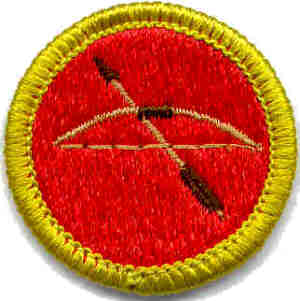
Archery
- Do the following:
- Name and explain the archery safety rules.
- Tell about the local and state laws on ownership, use and registration or archery tackle.
- Do the following:
- Name and point out the parts of an arrow.
- Name and point out the parts of a bow.
- Describe and show how to use an arm guard, shooting glove, finger tab, and quiver.
- Do the following:
- Explain proper care of and how to store the bow, bowstring, arrows, and leather items.
- Make a bowstring and use it.
- Make one complete arrow from a bare shaft.
- Explain the following terms: cast, bow weight, string height(fist-mele), aiming, spine, mechanical release, freestyle, and bare bow.
- Describe the different types of arrows.
- Show the nine basic steps of a good shooting method.
- Locate and mark with dental floss, crimp on, or other method the nocking point on a bow string.
- Shoot with bow and arrows, using a finger
release:
- One round from any of the following NFAA
field rounds and indoor rounds:
- A field round of 14 targets and make a score of 60 points
- An indoor round and make a score of 50 points
- A 900 round and make a score of 225 points (intermediates 15-17 years old)
- An indoor FITA round I and make a score of 80 points (Juniors up to 14 years old)
OR
- As a member of the NAA Junior Olympic Archery Development Club, qualify as a Yeoman, Junior Bowman, and Bowman. OR
- As a member of the NFAA Junior Division, qualify as a Cub or Youth by earning 100-score Progression Patches.
- One round from any of the following NFAA
field rounds and indoor rounds:
- Explain the following:
- The difference between field and target archery.
- Field round, hunter round, animal round.
- Scout field round.
- Indoor field rounds.
- 900, junior 900, Easton, and junior /easton rounds.
- Indoor FITA rounds I and II.
- FITA and junior FITA rounds.
- Junior Olympic qualification rounds.
- The importance of obedience to a rangemaster or other person in charge of a range.

Architecture
- Tour your community and list the different
building types you see. Try to identify buildings
that can be associated with a specific period of
history. Make a sketch of the building you most
admire.
- Arrange to meet with an architect. Ask to see the
architect's office and to talk about the
following:
- Careers in architecture
- Educational requirements
- Tools an architect uses
- Processes involved in a building project
- Careers in architecture
- Arrange to visit a construction project with the
project's architect. Ask to see the construction
drawings so that you can compare how the project
is drawn on paper to how it is actually built.
Notice the different building materials. Find out
how they are to be used, why then were selected,
and what determines how they are being put
together.
- Interview the owner or occupant of a home or
other building (your "client"). Find
out what your client's requirements would be for
designing a new home or business facility. Write
down all of your client's requirements that you
think would affect layout or design of the new
facility.
- Measure your bedroom. Make an accurately scaled
drawing of the floor plan indicating walls, doors
windows, and furniture. Neatly label your
drawing, including your name and the date.
(Drawing scale 1/4 = 1 foot)
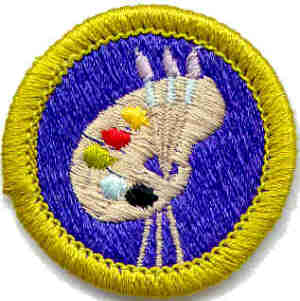
Art
- Tell a story with a picture or pictures.
- Promote a product or an idea with a picture or
pictures.
- Record in an art medium something that you have
done or seen.
- Decorate something with an original design. Put
the design on Scout equipment, furniture,
ceramics, or fabric.
- Design something useful.
- Render a subject of your choice in FOUR of these
ways: pen and ink, watercolor, pencil, pastel,
oil, tempera, acrylic, or marker.
- Discuss job opportunities in art.
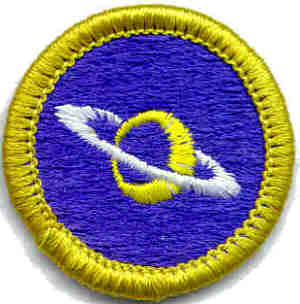
Astronomy
- Do the following:
- Sketch the face of the moon, indicating on it the locations of at least five seas and five craters.
- Within a single week sketch the position of the moon in the sky at the same hour on three different evenings. Explain the changes observed.
- Tell what factors keep the moon in orbit around the earth.
- Do ONE of the following:
- Photograph or locate on a map of the sky a planet at approximately weekly intervals at the same time of night for at least 4 weeks. Explain any changes noticed on the photographs or map.
- Find out when each of the five visible planets will be observable in the evening sky during the next 12 months and compile this information in the form of a chart or table.
- Do ONE of the following:
- In a sketch show the position of Venus, Mars or Jupiter in the sky at approximately weekly intervals at the same time for at least 4 weeks.
- Using a compass, record the direction to the sun at sunset at approximately weekly intervals for at least 4 weeks in spring or fall (for 6 to 8 weeks in summer or winter) and relate this information to the seasons of the earth.
- With the aid of diagrams explain the relative positions of sun, earth, moon at the times of lunar and solar eclipses and at the times of New, First Quarter, Full, and Last Quarter phases of the moon.
- Using the shadow of a vertical pole in sunshine, lay out a true north-south line (a meridian). Then, using a line and the pole on another day, measure the altitude of the noontime sun and determine your latitude.
- Identify in the sky at least 10 constellations,
four of which are in the Zodiac. Identify at
least eight conspicuous stars, five of which are
of first magnitude. Then do the following:
- Show in a sketch the position of the Big Dipper and its relation to the North Star and the horizon early some evening and again 6 hours later the same night. Record the date and time of making each sketch.
- Explain what we see when we look at the Milky Way.
- With the aid of diagrams (or real telescopes if available) explain the difference between reflecting and refracting telescopes. Describe the basic purpose of a telescope, and list at least three other instruments used with telescopes.
- Do the following:
- Describe the composition of the sun, its relationship to other stars and some effects of its radiation on the Earth's weather. Define sun-spots and describe some of the effects they may have on this radiation.
- Identify at least one star that is red, one that is blue, and one that is yellow, and explain the meaning of these colors.
- Do ONE of the following:
- Visit a planetarium or observatory and submit a report to your counselor both on the activities occurring there and on the exhibits of instruments and other astronomical objects you observed.
- Spend at least 3 hours observing celestial objects through a telescope or field glass, and write a report for your counselor on what you observed.
- Name different career opportunities in astronomy. Explain how to prepare for one of them. List the high school courses most useful in beginning such preparation.
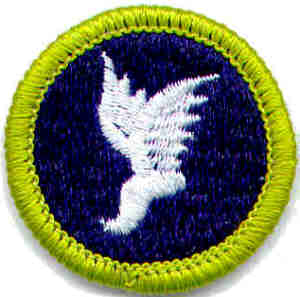
Athletics
- Write 500 words on how to train for sports.
- Give the rules for two track and two field events. Tell what an amateur is.
- Prepare plans for holding a sports meet. Outline duties of each official needed.
- Serve as an official in an athletic meet or major sport.
- Qualify in one event, for your weight, in each of the groups below.
*Boys under 140 lbs*
| GROUP 1 | Under 75 lbs |
Under 95 lbs |
Under 110 lbs |
Under 125 lbs |
Under 140 lbs |
| Running long jump | 10'2" | 11'6" | 12' | 13' | 14' |
| Running high jump | 3'2" | 3'6" | 3'9" | 4' | 4'3" |
| Standing long jump | 5'10" | 6'3" | 6'9" | 7'2" | 7'4" |
| Standing high jump | 2'6" | 3' | 3'2" | 3'4" | 3'6" |
| GROUP 2 | sec | sec | sec | sec | sec |
| 50-yard dash | 8 | 7-4/5 | 7-3/5 | 7-1/5 | 6-3/5 |
| 100-yard dash | 13 | 12-3/5 | 12-2/5 | ||
| 6-potato race | 36 | 28 | 27 | 26 | 25 |
| GROUP 3 | sec | sec | sec | sec | sec |
| 20-yard swim | 19-3/5 | 18-2/5 | 17-4/5 | 17-1/5 | 16-3/5 |
| 40-yard swim | 47 | 40 | 39 | 38 | 37 |
| GROUP 4 | |||||
| Pull-up | 3x | 5x | 6x | 8x | 10x |
| 8-lb shot put | 15' | 20' | 24' | 28' | 32' |
| Push-up from floor | 7x | 9x | 10x | 12x | 14x |
| Rope Climb 18 ft | 29 sec | 17 sec | 15 sec | 13 sec | 11 sec |
| GROUP 5 | |||||
| Baseball throw for accuracy (3 strikes 6 throws) |
42' | 48' | 51' | 54' | 57' |
| Baseball throw for distance | 120' | 150' | 175' | 195' | 210' |
| Basketball goal shooting (30 sec) |
5 in 8 | 5 in 8 | 6 in 9 | 7 in 10 | 8 in 11 |
*Boys 140 lbs and over*
| GROUP 1 | Under 160lbs |
Under 175lbs |
Under 200 lbs |
200 lbs or over |
|---|---|---|---|---|
| Running long jump | 15' | 16' | 14' | 10' |
| Running high jump | 4'2" | 4' | 3'6" | 3' |
| Standing long jump | 7'6" | 7'4" | 6' | 5' |
| Standing high jump | 3'8" | 3'5" | 3' | 2'4" |
| GROUP 2 | sec | sec | sec | sec |
| 50-yard dash | 6-3/5 | 7 | 7-3/5 | 8-2/5 |
| 100-yard dash | 12-4/5 | 14 | 15-3/5 | |
| 6-potato race | 24 | 28 | 32 | 36 |
| GROUP 3 | sec | sec | sec | sec |
| 20-yard swim | 16 | 15 | 15-4/5 | 18-3/5 |
| 40-yard swim | 36 | 35 | 39 | 40 |
| GROUP 4 | ||||
| Pull-up | 12x | 10x | 6x | 4x |
| 8-lb shot put | 34' | 36' | 37' | 38' |
| Push-up from floor | 16x | 17x | 12x | 8x |
| Rope Climb 18 ft | 14 sec | 17 sec | 20 sec | 25 sec |
| GROUP 5 | ||||
| Baseball throw for accuracy (3 strikes 6 throws) |
65' | 70' | 60' | 50' |
| Baseball throw for distance | 220' | 230' | 200' | 175' |
| Basketball goal shooting (30 sec) |
9in12 | 10in13 | 8in12 | 6in15 |
Atomic Energy
- Tell the meaning of the following: alpha particle, atom, background radiation, beta particle, curie, fall-out, half-life, ionization, isotope, neutron, neutron activation, nuclear energy, nuclear reactor, particle accelerator, radiation, radioactivity, Roentgen, and x ray.
- Make three-dimensional models of the atoms of the three isotopes of hydrogen. Show neutrons, protons, and electrons. Use these models to explain the difference between atomic weight and number.
- Make a drawing showing how nuclear fission happens. Label all details. Draw a second picture showing how a chain reaction could be started. Also show how it could be stopped. Show what is meant by a "critical mass."
- Tell who five of the following people were. Explain what each of the five discovered in the field of atomic energy: Henri Becquerel, Niels Bohr, Marie Curie, Albert Einstein, Enrico Fermi, Otto Hahn, Ernest Lawrence, Lise Meitner, William Roentgen, and Sir Ernest Rutherford. Explain how any one person's discovery was related to one other person's work.
- Draw and color the radiation hazard symbol. Explain where it should and should not be used. Tell why and how people must use radiation or radioactive materials carefully.
- Do any THREE of the following:
- Build an electroscope. Show how it works. Put a radiation source inside it. Explain any difference seen.
- Make a simple Geiger counter. Tell the parts. Tell which types of radiation the counter can spot. Tell how many counts per minute of what radiation you have found in your home.
- Build a model of a reactor. Show the fuel, the control rods, the shielding, the moderator, and any cooling material. Explain how a reactor could be used to change nuclear into electrical energy or make things radioactive.
- Use a Geiger counter and a radiation source. Show how the counts per minute change as the source gets closer. Put three different kinds of material between the source and the detector. Explain any differences in the counts per minute. Tell which is the best to shield people from radiation and why.
- Use fast-speed film and a radiation source. Show the principles of autoradiography and radiography. Explain what happened to the films. Tell how someone could use this in medicine, research, or industry.
- Using a Geiger counter (that you have built or borrowed), find a radiation source that has been hidden under a covering. Find it in a least three other places under the cover. Explain how someone could use this in medicine, research, agriculture, or industry.
- Visit a place where X ray is used. Draw a floor plan of the room in which it is used. Show where the unit, the person who runs it, and the patient would be when it is used. Describe the radiation dangers from x ray.
- Make a cloud chamber. Show how it can be used to see the tracks caused by radiation. Explain what is happening.
- Visit a place where radioisotopes are being used. Explain by drawing how and why it is used.
- Get samples of irradiated seeds. Plant them. Plant a group of nonirradiated seeds of the same kind. Grow both groups. List any differences. Discuss what irradiation does to seeds.
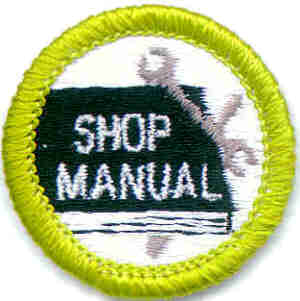
Automotive (Auto Mechanics?)
NOTE: Access to an automobile or truck (with owners manual) is needed to meet some of the requirements for this merit badge.
- Discuss with your counselor the safety equipment, tools, and clothing used while checking or repairing a motor vehicle. Use the equipment, tools, and/or clothing (when needed of called for) in meeting the requirements for this merit badge.
- Explain how an internal combustion engine operates and the differences between gasoline and diesel engines.
- Demonstrate you knowledge of general maintenance.
Do the following:
- Demonstrate how to check the fluid level
of the following:
- Brake Fluid
- Engine Oil
- Coolant
- Power steering fluid
- Windshield washer fluid
- Transmission fluid (automatic and standard)
- Check battery fluid, if possible, and the condition of battery terminals.
- Show the location of fuse boxes and the size of fuses, and demonstrate the proper replacement of burned-out fuses.
- Review the maintenance chart in the
owner's manual. Explain the requirements
and time limits.
- Choose a care cleaner and wax product for the vehicle. Explain clear-coat paint and the precautions necessary for care. Clean and wax the vehicle, both inside and out.
- Use a vinyl and rubber protectant (on vinyl tops, rubber door seals, sidewalls, etc.) and explain the importance of this protectant.
- Demonstrate how to check the condition and tension of belts and hoses.
- Demonstrate the following:
- Check the lighting in the vehicle, including instrument, warning, and exterior bulbs.
- Check headlight alignment.
- Demonstrate how to check the vehicle exhaust system.
- Demonstrate how to check the fluid level
of the following:
- Demonstrate your knowledge of the following:
- Explain the difference between tire and vehicle manufacturer's information specifications and demonstrate where to find these specifications.
- Demonstrate how to check pressure and properly inflate a tire.
- Using the manufacturer's jack supplied
with the vehicle:
- Demonstrate how to engage the jack correctly on the vehicle.
- Demonstrate how to correctly change a tire.
- Explain the difference between
bias-belted tires and radial-belted
tires.
- Diagram and explain in writing how to rotate bias-belted and radial-belted tires.
- Using the manufacturer's guidelines,
rotate the tires on the vehicle.
- Explain the camber, caster, and toe-in adjustments on wheel alignment.
- Explain why wheel alignment is important to the life of a tire.
- Explain the purpose of the lateral-wear bar indicator.
- Explain how to dispose of old tires properly.
- Demonstrate your knowledge of engine lubrication.
Do the following:
- Explain the purpose of motor oil.
- Explain where to find the recommended type and amount of oil to be used in the vehicle engine.
- Explain the difference in viscosity (10W/30 versus SAE 30).
- Perform an oil change and oil filter change on a vehicle.
- Explain how to dispose of the used oil and filter properly.
- Cooling system. Do the following:
- Explain the need for coolant in the cooling system.
- Flush and change the engine coolant in the vehicle according to the manufacturer's instructions.
- Explain how to dispose of used coolant properly.
- Demonstrate your knowledge of a fuel system. Do
the following:
- Explain how the air and fuel system work together.
- Explain how a carburetor works and how a fuel-injection system works.
- Explain how an on-board computer works with the fuel injection system. Show where the computer is located.
- Explain why it is necessary to have an air filter and a fuel filter. Locate them and change them according to the manufacturer's recommendations.
- Explain what fuel additives are for both the carburetor and the fuel injection systems.
- Demonstrate your knowledge of ignition and
electrical systems. Do the following:
- Diagram and explain the parts of the electrical system.
- Explain the cylinder engine sequence.
- Explain the spark plug gap and if practical, change the spark plug. (Use an engine with spark plugs that can be reached without tilting the engine.)
- Demonstrate how to connect jumper cables on your battery properly. Explain how to jump-start a vehicle.
- Explain the difference between electronic and point ignition systems.
- Demonstrate your knowledge of a drive train. Do
the following:
- Diagram the drive train and explain the different parts.
- Explain the difference between automatic and standard transmissions.
- Explain the types of automatic transmission fluid.
- Explain the types of lubricants used in a standard transmission and in the differential.
- Explain the difference between front-wheel, rear-wheel, and four-wheel drive.
- Explain the gear ratio of the differential.
- Demonstrate you knowledge of a brake system. Do
the following:
- Explain the brake system (including anti-lock systems) and how it operates.
- Explain the differences between disk and shoe systems.
- Demonstrate checking conditions on a vehicle brake system. After checking make a recommendation for repairs (if necessary).
- Explain the purpose, importance, and limitations of passive restraints.
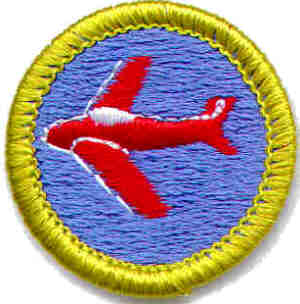
Aviation
- Do the following:
- Describe how aviation has affected our world.
- Define "aircraft". Describe some kinds of aircraft in use today.
- List at least 10 uses of aircraft.
- Do the following:
- Point out on a model plane the forces that act on an airplane in flight.
- Applying Bernoulli's Principle, explain how an airfoil generates lift, how the primary control surfaces (ailerons, elevator, and rudder) affect the aircraft's altitude, and how a propeller produces thrust.
- Show how the control surfaces of an airplane are used for takeoff, straight climb, level turn, climbing turn, descending turn, straight descent, and landing.
- Identify the following aircraft instruments and explain the purposes of each: attitude indicator, altimeter, airspeed indicator, compass, turn and bank indicator, tachometer, oil pressure gauge, and temperature gauge.
- Explain the differences in the operation of piston, turbojet, turboprop, and turbofan engines.
- Tell six rules of safety to follow around airplanes and airports.
- Do TWO of the following:
- Take a flight in an aircraft. Record the date, place, type of aircraft, duration of flight, and your impressions of the flight.
- On a map mark a route for an imaginary trip of at least 3,000 miles. Start from the commercial airport nearest your home. Travel three of more different airlines. From timetables, decide from when you will get to and leave from all connecting points.
- Visit a modern airport. After the visit tell how the facilities are used.
- Under supervision, perform a preflight inspection of a light plane.
- Learn how to read an aeronautical chart. Measure a true course on the chart. Correct it for magnetic variation, compass deviation, and wind drift. Arrive at a compass heading.
- Build and fly a fuel-driven model airplane. Describe safety rules for building and flying model airplanes. Tell safety rules for use of glue, dope, paint, and plastics.
- Find out what job opportunities there are in aviation. Describe the qualifications and working conditions on one job in which you are interested. Tell what it offers for reaching your goal in life.